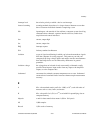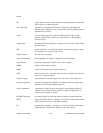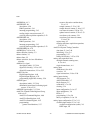
Glossary
©
National Instruments Corporation G-21 AT-MIO-16X User Manual
RTSI Real-Time System Integration
RTSI bus real-time system integration bus—the National Instruments timing bus
that connects DAQ boards directly, by means of connectors on top of
the boards, for precise synchronization of functions
S
s seconds
Ssamples
sample counter the clock that counts the output of the channel clock, in other words, the
number of samples taken. On boards with simultaneous sampling, this
counter counts the output of the scan clock and hence the number of
scans.
SCADA supervisory control and data acquisition—a common PC function in
process control applications, where programmable logic controllers
(PLCs) perform control functions but are monitored and supervised by
a PC
scan one or more analog or digital input samples. Typically, the number of
input samples in a scan is equal to the number of channels in the input
group. For example, one pulse from the scan clock produces one scan
which acquires one new sample from every analog input channel in the
group.
scan clock the clock controlling the time interval between scans. On boards with
interval scanning support (for example, the AT-MIO-16F-5), this clock
gates the channel clock on and off. On boards with simultaneous
sampling (for example, the EISA-A2000), this clock clocks the
track-and-hold circuitry.
scan rate the number of scans per second. For example, a scan rate of 10 Hz
means sampling each channel 10 times per second.
SCXI Signal Conditioning eXtensions for Instrumentation—the National
Instruments product line for conditioning low-level signals within an
external chassis near sensors so only high-level signals are sent to DAQ
boards in the noisy PC environment
SDK software development kit


















